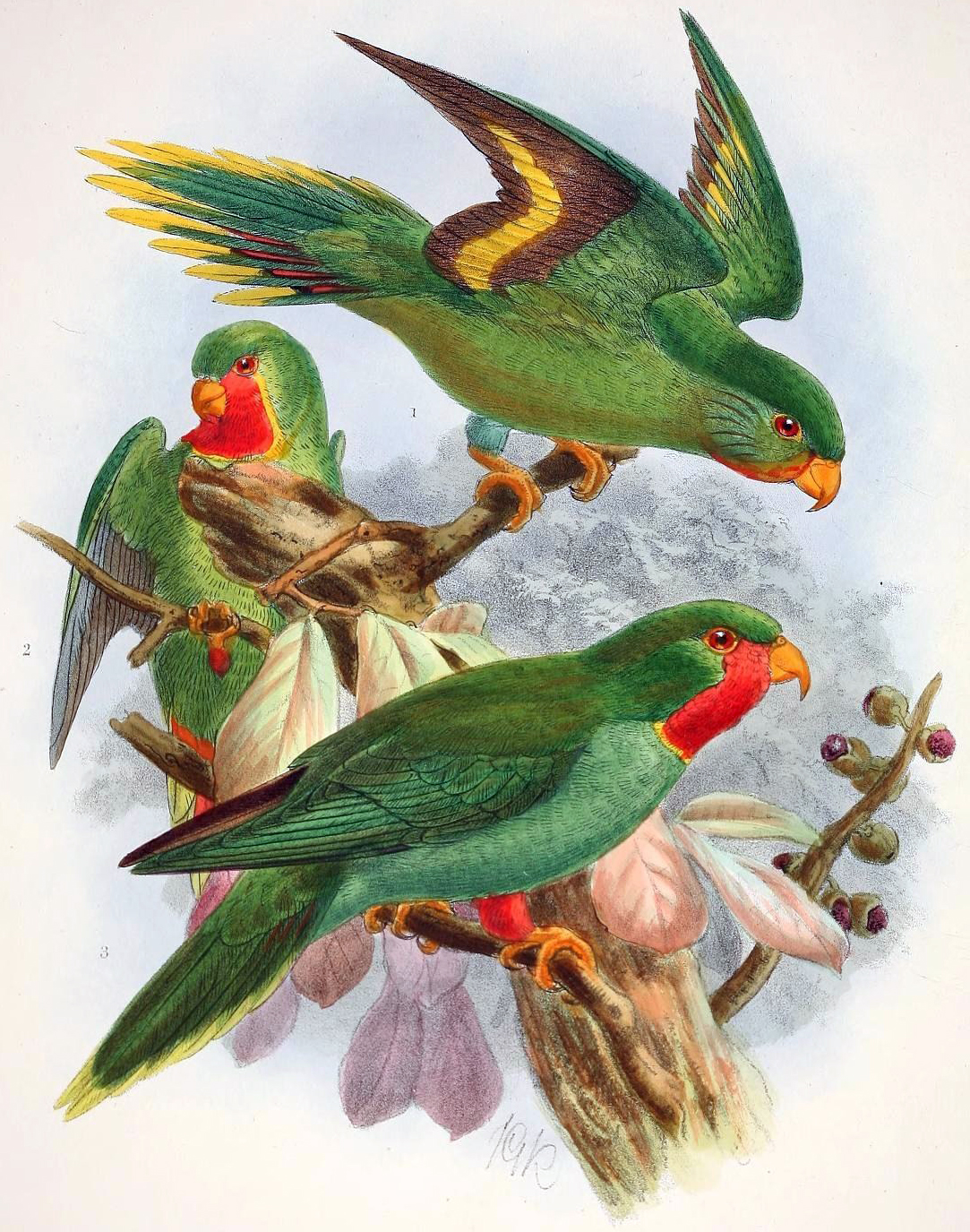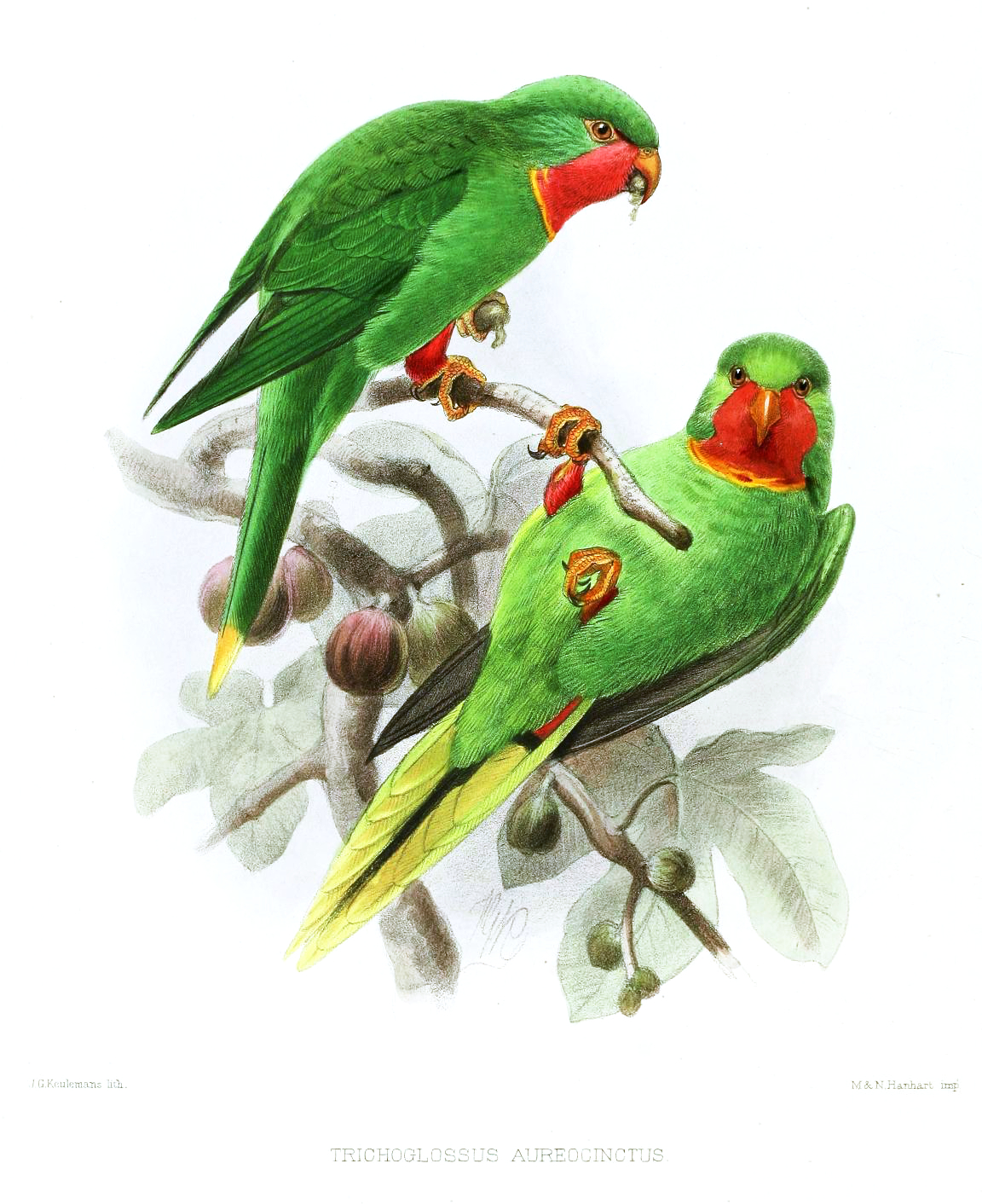|
Red-throated Lorikeet
The red-throated lorikeet (''Vini amabilis'') is a critically endangered lorikeet endemic to Fiji. It is 18 cm long and is bright green overall, with red cheeks, throat and thighs. This bird has been found on the islands of Viti Levu, Vanua Levu, Taveuni and Ovalau. Ten specimens were collected in 1923, but it was last recorded in 1993, although it may also have been seen on Mount Tomanivi on Viti Levu in 2001. A search of Viti Levu in 2001-2 failed to find any birds, as did a second series of surveys in 2003. It continues to be threatened by habitat loss, the introduced black rat, as well as introduced feral cats and small Indian mongooses. It is known as the Kulawai in Fiji and is the bird found on the Fijian $5 bills. Taxonomy This species was formerly assigned to the genus ''Charmosyna''. It was moved to the genus '' Vini'' based on a molecular phylogenetic Molecular phylogenetics () is the branch of phylogeny that analyzes genetic, hereditary molecular differences ... [...More Info...] [...Related Items...] OR: [Wikipedia] [Google] [Baidu] |
Edward Pierson Ramsay
Edward Pierson Ramsay (3 December 1842 – 16 December 1916) was an Australian zoologist who specialised in ornithology. Early life Ramsay was born in Dobroyd Estate, Long Cove, Sydney, and educated at St Mark's Collegiate School, The King's School, Parramatta. He studied medicine from 1863 to 1865 at the University of Sydney but did not graduate. Career Although he never had had any formal scientific training in zoology, Ramsay had a keen interest in natural history and published many papers. In 1863 he was treasurer of the Entomological Society of New South Wales, he contributed a paper on the "Oology of Australia" to the Philosophical Society in July 1865, and when this society was merged into the Royal Society of New South Wales, he was made a life member in recognition of the work he had done for the Philosophical Society. In 1868 Ramsay joined with his brothers in a sugar-growing plantation in Queensland which, however, was not successful. Ramsay was one of the foundati ... [...More Info...] [...Related Items...] OR: [Wikipedia] [Google] [Baidu] |
Feral Cats
A feral cat or a stray cat is an unowned domestic cat (''Felis catus'') that lives outdoors and avoids human contact; it does not allow itself to be handled or touched, and usually remains hidden from humans. Feral cats may breed over dozens of generations and become a local apex predator in urban, savannah and bushland environments, and especially on islands where native animals did not evolve alongside predators. Some feral cats may become more comfortable with people who regularly feed them, but even with long-term attempts at socialization, they usually remain aloof and reject human touch. Of the 700 million cats in the world, an estimated 480 million are feral. Feral cats are devastating to wildlife, and conservation biologists consider them to be one of the worst invasive species on Earth. They are included in the list of the world's 100 worst invasive alien species. Attempts to control feral cat populations are widespread but generally of greatest impact within purpos ... [...More Info...] [...Related Items...] OR: [Wikipedia] [Google] [Baidu] |
Birds Described In 1875
Birds are a group of warm-blooded vertebrates constituting the class Aves (), characterised by feathers, toothless beaked jaws, the laying of hard-shelled eggs, a high metabolic rate, a four-chambered heart, and a strong yet lightweight skeleton. Birds live worldwide and range in size from the bee hummingbird to the common ostrich. There are over 11,000 living species and they are split into 44 orders. More than half are passerine or "perching" birds. Birds have wings whose development varies according to species; the only known groups without wings are the extinct moa and elephant birds. Wings, which are modified forelimbs, gave birds the ability to fly, although further evolution has led to the loss of flight in some birds, including ratites, penguins, and diverse endemic island species. The digestive and respiratory systems of birds are also uniquely adapted for flight. Some bird species of aquatic environments, particularly seabirds and some waterbirds, have furth ... [...More Info...] [...Related Items...] OR: [Wikipedia] [Google] [Baidu] |
Endemic Birds Of Fiji
Endemism is the state of a species being found only in a single defined geographic location, such as an island, state, nation, country or other defined zone; organisms that are indigenous to a place are not endemic to it if they are also found elsewhere. For example, the Cape sugarbird is found exclusively in southwestern South Africa and is therefore said to be ''endemic'' to that particular part of the world. An endemic species can also be referred to as an ''endemism'' or, in scientific literature, as an ''endemite''. Similarly, many species found in the Western ghats of India are examples of endemism. Endemism is an important concept in conservation biology for measuring biodiversity in a particular place and evaluating the risk of extinction for species. Endemism is also of interest in evolutionary biology, because it provides clues about how changes in the environment cause species to undergo range shifts (potentially expanding their range into a larger area or becomin ... [...More Info...] [...Related Items...] OR: [Wikipedia] [Google] [Baidu] |
Vini (bird)
''Vini'' is a genus of birds in the family Psittaculidae that are endemic to the islands of the tropical Pacific. There are eleven extant species of these small lorikeets ranging from the Bismark Archipelago through Fiji, Samoa, French Polynesia, and as far east as Henderson Island. All members of the genus have exceptional bright plumage, particularly the unusual all over blues of the blue lorikeet and the ultramarine lorikeet. The ''Vini'' lorikeets are highly threatened by human changes to their islands. Most species have been lost from a number of islands and two species became extinct before the arrival of European explorers in the Pacific. , two species are listed as endangered species by the IUCN and two are considered vulnerable. They are primarily threatened by introduced species, such as rats, and habitat loss. Taxonomy The genus ''Vini'' was introduced in 1833 by the French naturalist René Lesson for Kuhl's lorikeet. For the publication date see: The genus name ... [...More Info...] [...Related Items...] OR: [Wikipedia] [Google] [Baidu] |
Molecular Phylogenetic
Molecular phylogenetics () is the branch of phylogeny that analyzes genetic, hereditary molecular differences, predominantly in DNA sequences, to gain information on an organism's evolutionary relationships. From these analyses, it is possible to determine the processes by which diversity among species has been achieved. The result of a molecular phylogenetic analysis is expressed in a phylogenetic tree. Molecular phylogenetics is one aspect of molecular systematics, a broader term that also includes the use of molecular data in taxonomy and biogeography. Molecular phylogenetics and molecular evolution correlate. Molecular evolution is the process of selective changes (mutations) at a molecular level (genes, proteins, etc.) throughout various branches in the tree of life (evolution). Molecular phylogenetics makes inferences of the evolutionary relationships that arise due to molecular evolution and results in the construction of a phylogenetic tree. History The theoretical fra ... [...More Info...] [...Related Items...] OR: [Wikipedia] [Google] [Baidu] |
Vini (genus)
''Vini'' is a genus of birds in the family Psittaculidae that are endemism, endemic to the islands of the tropical Pacific. There are eleven extant species of these small Lories and lorikeets, lorikeets ranging from the Bismark Archipelago through Fiji, Samoa, French Polynesia, and as far east as Henderson Island (Pitcairn Islands), Henderson Island. All members of the genus have exceptional bright plumage, particularly the unusual all over blues of the blue lorikeet and the ultramarine lorikeet. The ''Vini'' lorikeets are highly threatened by human changes to their islands. Most species have been lost from a number of islands and two species became extinct before the arrival of European explorers in the Pacific. , two species are listed as endangered species by the IUCN and two are considered Vulnerable species, vulnerable. They are primarily threatened by introduced species, such as rats, and habitat loss. Taxonomy The genus ''Vini'' was introduced in 1833 by the French natural ... [...More Info...] [...Related Items...] OR: [Wikipedia] [Google] [Baidu] |
Charmosyna
''Charmosyna'' is a genus of parrots in the family Psittaculidae. The three currently recognized species inhabit moist forests on the island of New Guinea. Taxonomy ''Charmosyna'' contains the following three species: The genus formerly included twelve additional species: pygmy lorikeet (''Charminetta wilhelminae''), red-fronted lorikeet (''Hypocharmosyna rubronotata''), red-flanked lorikeet (''Hypocharmosyna placentis''), blue-fronted lorikeet (''Charmosynopsis toxopei''), fairy lorikeet (''Charmosynopsis pulchella''), striated lorikeet (''Synorhacma multistriata''), duchess lorikeet (''Charmosynoides margarethae''), Meek's lorikeet (''Vini meeki''), red-chinned lorikeet (''Vini rubrigularis''), palm lorikeet (''Vini palmarum''), red-throated lorikeet (''Vini amabilis''), and New Caledonian lorikeet (''Vini diadema''). These were moved to other genera based on the results of a molecular phylogenetic Molecular phylogenetics () is the branch of phylogeny tha ... [...More Info...] [...Related Items...] OR: [Wikipedia] [Google] [Baidu] |
Small Indian Mongoose
The small Indian mongoose (''Urva auropunctata'') is a mongoose species native to Iraq and northern India; it has also been introduced to several Caribbean and Pacific islands. Taxonomy ''Mangusta auropunctata'' was the scientific name proposed by Brian Houghton Hodgson in 1836 for a mongoose specimen collected in central Nepal. In the 19th and 20th centuries, several zoological specimens were described: *''Mangusta pallipes'' proposed by Edward Blyth in 1845 was based on mongooses observed in Kandahar, Afghanistan. *''Herpestes palustris'' proposed by R. K. Ghose in 1965 was an adult male mongoose collected in a swamp on the eastern fringe of Kolkata, India. The small Indian mongoose was later classified in the genus '' Herpestes''; all Asian mongooses are now classified the genus '' Urva''. The small Indian mongoose was once considered a subspecies of the Javan mongoose (''H. javanicus''). Genetic analysis of hair and tissue samples from 18 small Indian and Javan mongooses ... [...More Info...] [...Related Items...] OR: [Wikipedia] [Google] [Baidu] |
Black Rat
The black rat (''Rattus rattus''), also known as the roof rat, ship rat, or house rat, is a common long-tailed rodent of the stereotypical rat genus ''Rattus'', in the subfamily Murinae. It likely originated in the Indian subcontinent, but is now found worldwide. The black rat is black to light brown in colour with a lighter underside. It is a generalist omnivore and a serious Pest (organism), pest to farmers because it feeds on a wide range of agricultural crops. It is sometimes kept as a pet. In parts of India, it is considered sacred and respected in the Karni Mata Temple in Deshnoke. Taxonomy ''Mus rattus'' was the scientific name proposed by Carl Linnaeus in 1758 for the black rat. Three subspecies were once recognized, but today are considered invalid and are now known to be actually Morph (zoology), color morphs: *''Rattus rattus rattus'' – roof rat *''Rattus rattus alexandrinus'' – Alexandrine rat *''Rattus rattus frugivorus'' – fruit rat Characteristics A ty ... [...More Info...] [...Related Items...] OR: [Wikipedia] [Google] [Baidu] |
Lories And Lorikeets
Loriini is a tribe of small to medium-sized arboreal parrots characterized by their specialized brush-tipped tongues for feeding on nectar of various blossoms and soft fruits, preferably berries. The species form a monophyletic group within the parrot family Psittaculidae. The group consists of the lories and lorikeets. Traditionally, they were considered a separate subfamily (Loriinae) from the other subfamily (Psittacinae) based on the specialized characteristics, but recent molecular and morphological studies show that the group is positioned in the middle of various other groups. They are widely distributed throughout the Australasian region, including south-eastern Asia, Polynesia, Papua New Guinea, Timor Leste and Australia, and the majority have very brightly coloured plumage. Etymology The word "lory" comes from the Malay ''lūri'', a name used for a number of species of colourful parrots. The name was used by the Dutch writer Johan Nieuhof in 1682 in a book describing h ... [...More Info...] [...Related Items...] OR: [Wikipedia] [Google] [Baidu] |







